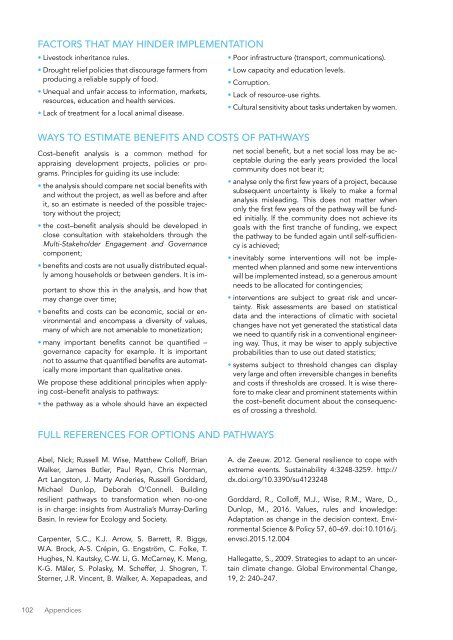DESIGNING PROJECTS IN A RAPIDLY CHANGING WORLD
srun3013fp1
srun3013fp1
You also want an ePaper? Increase the reach of your titles
YUMPU automatically turns print PDFs into web optimized ePapers that Google loves.
FACTORS THAT MAY H<strong>IN</strong>DER IMPLEMENTATION<br />
• Livestock inheritance rules.<br />
• Drought relief policies that discourage farmers from<br />
producing a reliable supply of food.<br />
• Unequal and unfair access to information, markets,<br />
resources, education and health services.<br />
• Lack of treatment for a local animal disease.<br />
WAYS TO ESTIMATE BENEFITS AND COSTS OF PATHWAYS<br />
Cost–benefit analysis is a common method for<br />
appraising development projects, policies or programs.<br />
Principles for guiding its use include:<br />
• the analysis should compare net social benefits with<br />
and without the project, as well as before and after<br />
it, so an estimate is needed of the possible trajectory<br />
without the project;<br />
• the cost–benefit analysis should be developed in<br />
close consultation with stakeholders through the<br />
Multi-Stakeholder Engagement and Governance<br />
component;<br />
• benefits and costs are not usually distributed equally<br />
among households or between genders. It is important<br />
to show this in the analysis, and how that<br />
may change over time;<br />
• benefits and costs can be economic, social or environmental<br />
and encompass a diversity of values,<br />
many of which are not amenable to monetization;<br />
• many important benefits cannot be quantified –<br />
governance capacity for example. It is important<br />
not to assume that quantified benefits are automatically<br />
more important than qualitative ones.<br />
We propose these additional principles when applying<br />
cost–benefit analysis to pathways:<br />
• the pathway as a whole should have an expected<br />
FULL REFERENCES FOR OPTIONS AND PATHWAYS<br />
• Poor infrastructure (transport, communications).<br />
• Low capacity and education levels.<br />
• Corruption.<br />
• Lack of resource-use rights.<br />
• Cultural sensitivity about tasks undertaken by women.<br />
net social benefit, but a net social loss may be acceptable<br />
during the early years provided the local<br />
community does not bear it;<br />
• analyse only the first few years of a project, because<br />
subsequent uncertainty is likely to make a formal<br />
analysis misleading. This does not matter when<br />
only the first few years of the pathway will be funded<br />
initially. If the community does not achieve its<br />
goals with the first tranche of funding, we expect<br />
the pathway to be funded again until self-sufficiency<br />
is achieved;<br />
• inevitably some interventions will not be implemented<br />
when planned and some new interventions<br />
will be implemented instead, so a generous amount<br />
needs to be allocated for contingencies;<br />
• interventions are subject to great risk and uncertainty.<br />
Risk assessments are based on statistical<br />
data and the interactions of climatic with societal<br />
changes have not yet generated the statistical data<br />
we need to quantify risk in a conventional engineering<br />
way. Thus, it may be wiser to apply subjective<br />
probabilities than to use out dated statistics;<br />
• systems subject to threshold changes can display<br />
very large and often irreversible changes in benefits<br />
and costs if thresholds are crossed. It is wise therefore<br />
to make clear and prominent statements within<br />
the cost–benefit document about the consequences<br />
of crossing a threshold.<br />
Abel, Nick; Russell M. Wise, Matthew Colloff, Brian<br />
Walker, James Butler, Paul Ryan, Chris Norman,<br />
Art Langston, J. Marty Anderies, Russell Gorddard,<br />
Michael Dunlop, Deborah O’Connell. Building<br />
resilient pathways to transformation when no-one<br />
is in charge: insights from Australia’s Murray-Darling<br />
Basin. In review for Ecology and Society.<br />
Carpenter, S.C., K.J. Arrow, S. Barrett, R. Biggs,<br />
W.A. Brock, A-S. Crépin, G. Engström, C. Folke, T.<br />
Hughes, N. Kautsky, C-W. Li, G. McCarney, K. Meng,<br />
K-G. Mäler, S. Polasky, M. Scheffer, J. Shogren, T.<br />
Sterner, J.R. Vincent, B. Walker, A. Xepapadeas, and<br />
A. de Zeeuw. 2012. General resilience to cope with<br />
extreme events. Sustainability 4:3248-3259. http://<br />
dx.doi.org/10.3390/su4123248<br />
Gorddard, R., Colloff, M.J., Wise, R.M., Ware, D.,<br />
Dunlop, M., 2016. Values, rules and knowledge:<br />
Adaptation as change in the decision context. Environmental<br />
Science & Policy 57, 60–69. doi:10.1016/j.<br />
envsci.2015.12.004<br />
Hallegatte, S., 2009. Strategies to adapt to an uncertain<br />
climate change. Global Environmental Change,<br />
19, 2: 240–247.<br />
102 Appendices


